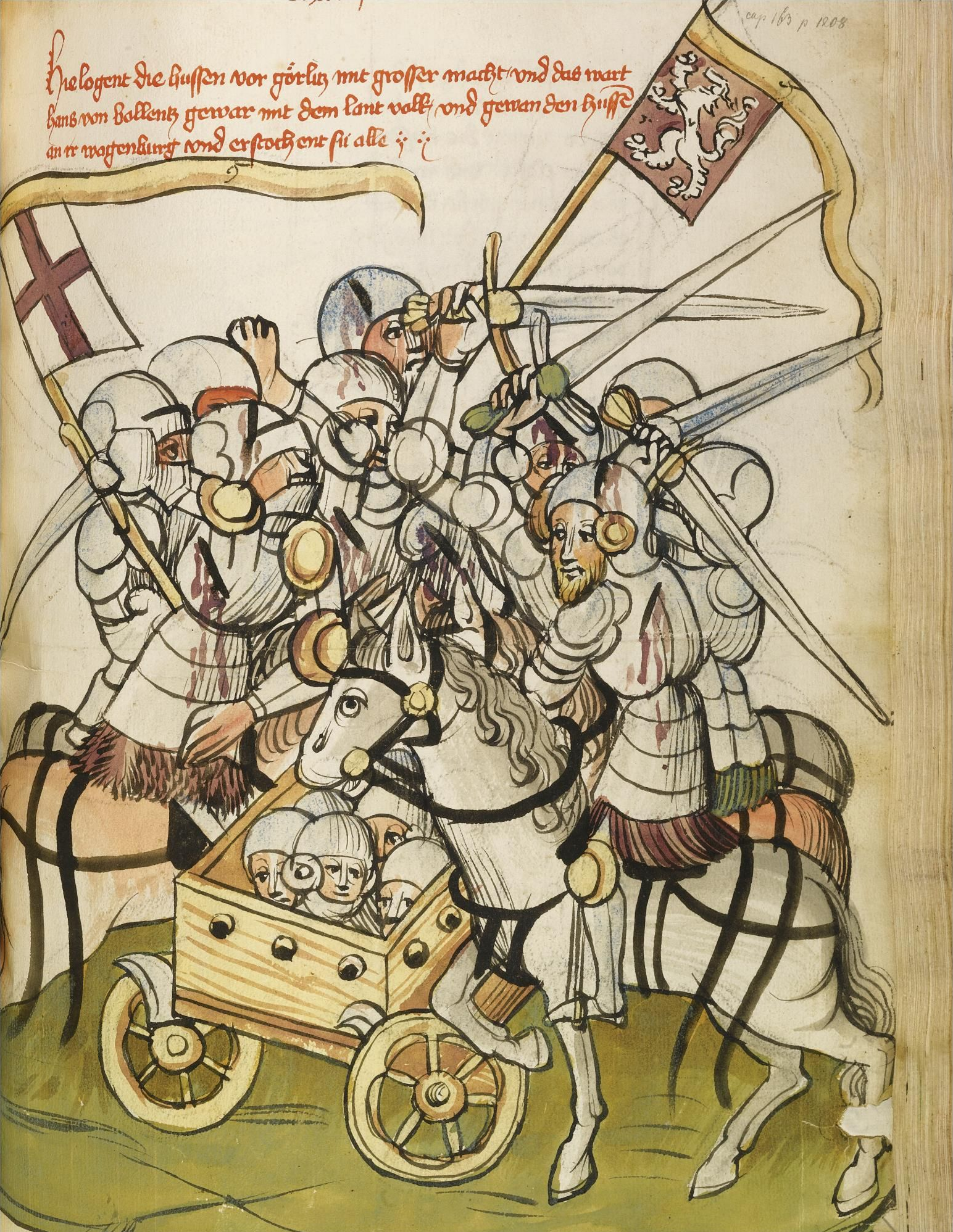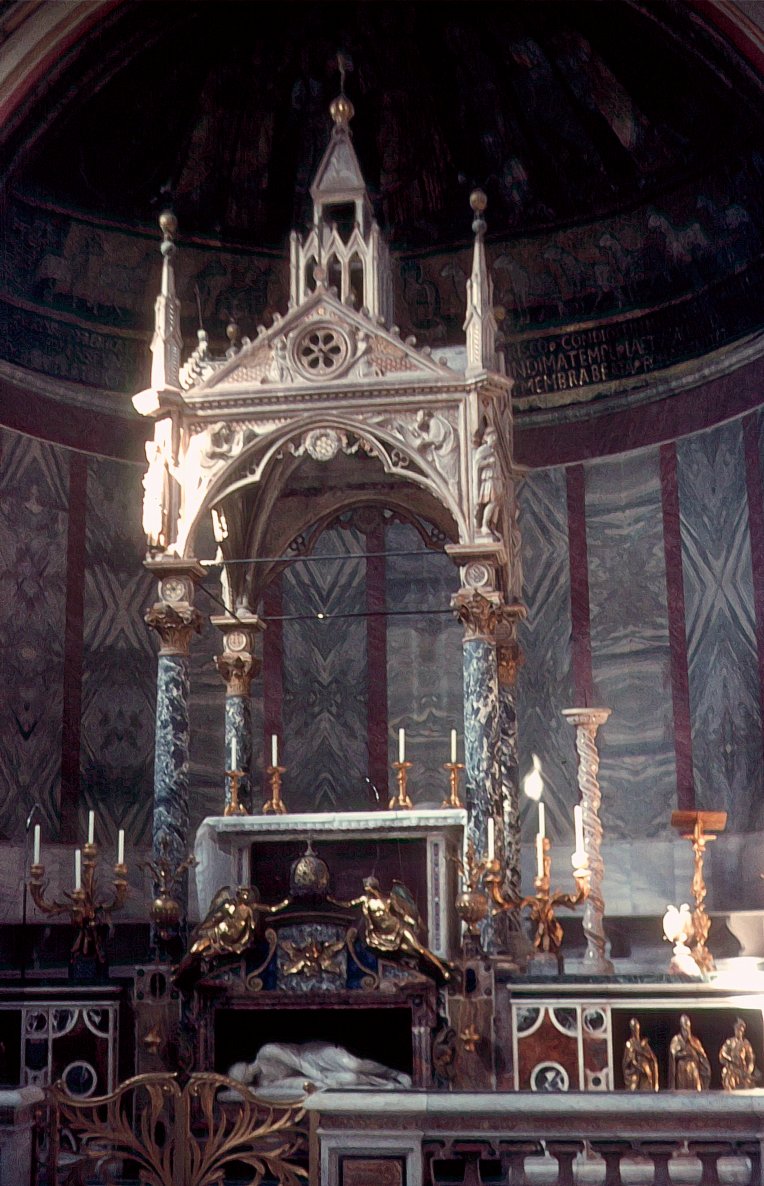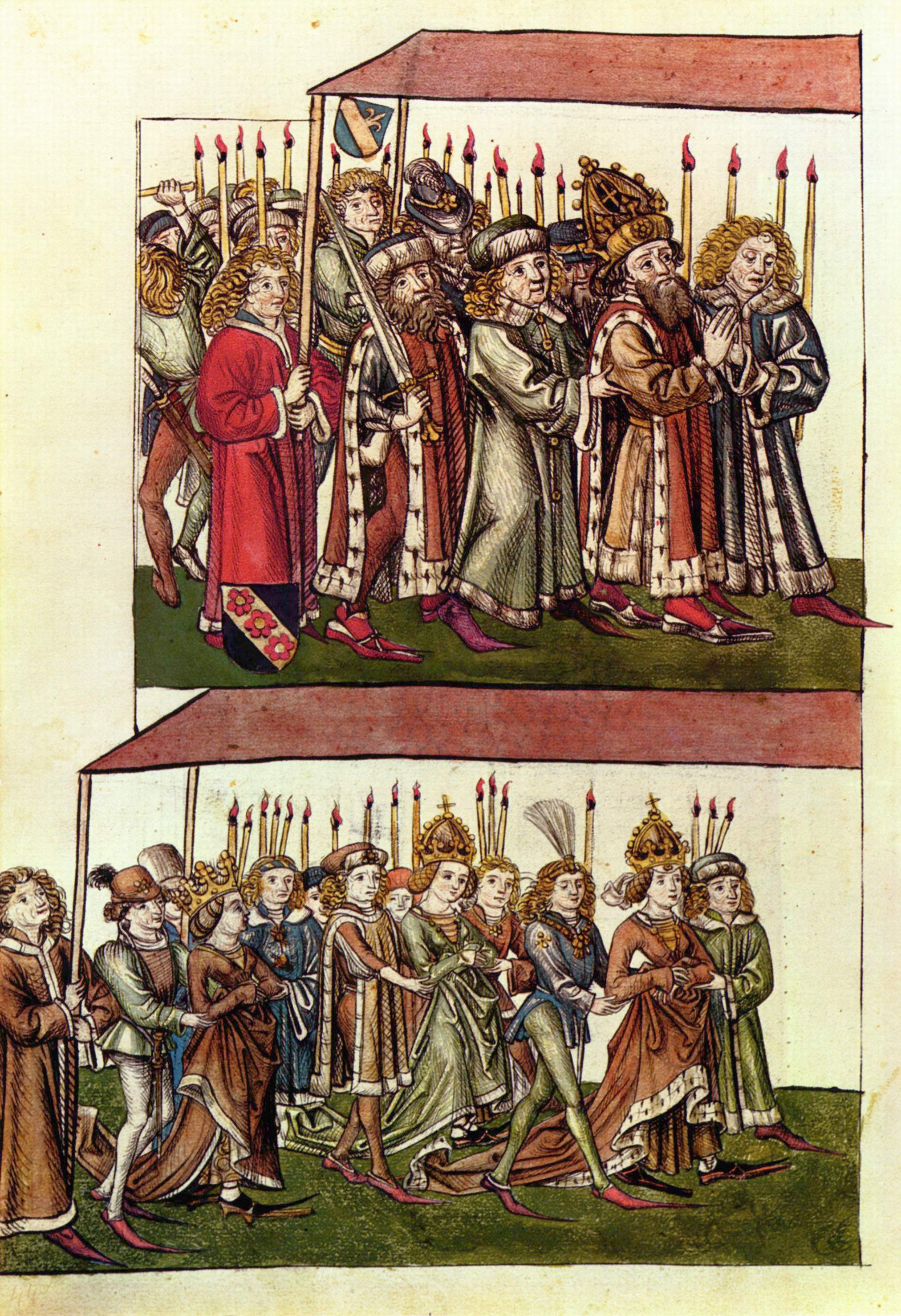|
Hussitism
upright=1.2, Battle between Hussites (left) and Crusades#Campaigns against heretics and schismatics, Catholic crusaders in the 15th century upright=1.2, The Lands of the Bohemian Crown during the Hussite Wars. The movement began during the Prague.html" ;"title="Renaissance in Prague">Renaissance in Prague and quickly spread south and then through the rest of the Kingdom of Bohemia. Eventually, it expanded into the remaining domains of the Bohemian Crown as well. The Hussites (Czech: ''Husité'' or ''Kališníci'', "Chalice People"; Latin: ''Hussitae'') were a Czech Proto-Protestantism, proto-Protestant Christian movement influenced by both the Byzantine Rite and John Wycliffe that followed the teachings of reformer Jan Hus (fl. 1401–1415), a part of the Bohemian Reformation. The Czech lands had originally been Christianized by Byzantine Greek missionaries Saints Cyril and Methodius, who introduced the Byzantine Rite in the Old Church Slavonic liturgical language and the By ... [...More Info...] [...Related Items...] OR: [Wikipedia] [Google] [Baidu] |
Jan Hus
Jan Hus (; ; 1369 – 6 July 1415), sometimes anglicized as John Hus or John Huss, and referred to in historical texts as ''Iohannes Hus'' or ''Johannes Huss'', was a Czechs, Czech theologian and philosopher who became a Church reformer and the inspiration of Hussites, Hussitism, a key predecessor to Protestantism, and a seminal figure in the Bohemian Reformation. Hus is considered to be the first Church reformer, even though some designate the theorist John Wycliffe. His teachings had a strong influence, most immediately in the approval of a reformed Bohemian religious denomination and, over a century later, on Martin Luther. After being ordained as a Catholic priest, Hus began to preach in Prague. He opposed many aspects of the Catholic Church in Bohemia, such as its views on ecclesiology, simony, the Eucharist, and other theological topics. Hus was a master, dean and rector at the Charles University in Prague between 1409 and 1410. Antipope Alexander V, Alexander V issued ... [...More Info...] [...Related Items...] OR: [Wikipedia] [Google] [Baidu] |
Hussite Wars
The Hussite Wars, also called the Bohemian Wars or the Hussite Revolution, were a series of civil wars fought between the Hussites and the combined Catholic forces of Sigismund, Holy Roman Emperor, Holy Roman Emperor Sigismund, the Papacy, and European monarchs loyal to the Catholic Church, as well as various Hussite factions. At a late stage of the conflict, the Utraquists changed sides in 1432 to fight alongside Roman Catholics and opposed the Taborites and other Hussite factions. These wars lasted from 1419 to approximately 1434. The unrest began after pre-Protestant Christian reformer Jan Hus was executed by the Catholic Church in 1415 for heresy. Because Sigismund had plans to be crowned the Holy Roman Emperor (requiring papal coronation), he suppressed the religion of the Hussites, yet it continued to spread. When King Wenceslaus IV of Bohemia, brother of Sigismund, died of natural causes a few years later, the tension stemming from the Hussites grew stronger. In Prague ... [...More Info...] [...Related Items...] OR: [Wikipedia] [Google] [Baidu] |
Christian Movement
A Christian movement is a Christian theology, theological, political, or philosophical interpretation of Christianity that is not generally represented by a specific Christian church, church, sect, or Christian denomination, denomination. Religious * The modern 24-7 Prayer Movement: a movement spanning denominations focusing on the pursuit of God as the focus of one's life. The International House of Prayer in Kansas City, MO is a visible example of this concept. * Anti-Judaism: The Quartodeciman controversy erupted in the 2nd century, and the anti-Quartodeciman position became Catholic doctrine at the First Council of Nicea, severing Easter from Passover both thematically and calendrically. Christians, thereafter, including all major Protestant churches, have felt justified in considering themselves as having replaced the Jews, believing that a new covenant has Supersessionism, superseded and Abrogation of Old Covenant laws, abrogated the original covenants with the Israelites a ... [...More Info...] [...Related Items...] OR: [Wikipedia] [Google] [Baidu] |
Roman Rite
The Roman Rite () is the most common ritual family for performing the ecclesiastical services of the Latin Church, the largest of the ''sui iuris'' particular churches that comprise the Catholic Church. The Roman Rite governs Rite (Christianity), rites such as the Roman Mass and the Liturgy of the Hours as well as the manner in which Sacraments of the Catholic Church, sacraments and Blessing in the Catholic Church, blessings are performed. The Roman Rite developed in the Latin language in the city of Rome and, while distinct Latin liturgical rites such as the Ambrosian Rite remain, the Roman Rite has gradually been adopted almost everywhere in the Latin Church. In medieval times there were numerous local variants, even if all of them did not amount to distinct rites, yet uniformity increased as a result of the invention of printing and in obedience to the decrees of the Council of Trent of 1545–1563 (see ''Quo primum''). Several Latin liturgical rites which had survived into th ... [...More Info...] [...Related Items...] OR: [Wikipedia] [Google] [Baidu] |
Catholic
The Catholic Church (), also known as the Roman Catholic Church, is the List of Christian denominations by number of members, largest Christian church, with 1.27 to 1.41 billion baptized Catholics Catholic Church by country, worldwide as of 2025. It is among the world's oldest and largest international institutions and has played a prominent role in the history and development of Western civilization.Gerald O'Collins, O'Collins, p. v (preface). The church consists of 24 Catholic particular churches and liturgical rites#Churches, ''sui iuris'' (autonomous) churches, including the Latin Church and 23 Eastern Catholic Churches, which comprise almost 3,500 dioceses and Eparchy, eparchies List of Catholic dioceses (structured view), around the world, each overseen by one or more Bishops in the Catholic Church, bishops. The pope, who is the bishop of Rome, is the Papal supremacy, chief pastor of the church. The core beliefs of Catholicism are found in the Nicene Creed. The ... [...More Info...] [...Related Items...] OR: [Wikipedia] [Google] [Baidu] |
Council Of Constance
The Council of Constance (; ) was an ecumenical council of the Catholic Church that was held from 1414 to 1418 in the Bishopric of Constance (Konstanz) in present-day Germany. This was the first time that an ecumenical council was convened in the Holy Roman Empire. The council ended the Western Schism by deposing or accepting the resignation of the remaining papal claimants and by electing Pope Martin V. It was the last papal election to take place outside of Italy. The council also condemned Jan Hus as a heretic and facilitated his execution; and it ruled on issues of national sovereignty and the rights of pagans and just war in response to a conflict between the Grand Duchy of Lithuania, the Kingdom of Poland and the Order of the Teutonic Knights. The council is also important for its role in the debates over ecclesial conciliarism and papal supremacy. Constance issued two particularly significant decrees regarding the constitution of the Catholic Church: '' Haec sancta'' ... [...More Info...] [...Related Items...] OR: [Wikipedia] [Google] [Baidu] |
Renaissance
The Renaissance ( , ) is a Periodization, period of history and a European cultural movement covering the 15th and 16th centuries. It marked the transition from the Middle Ages to modernity and was characterized by an effort to revive and surpass the ideas and achievements of classical antiquity. Associated with great social change in most fields and disciplines, including Renaissance art, art, Renaissance architecture, architecture, politics, Renaissance literature, literature, Renaissance exploration, exploration and Science in the Renaissance, science, the Renaissance was first centered in the Republic of Florence, then spread to the Italian Renaissance, rest of Italy and later throughout Europe. The term ''rinascita'' ("rebirth") first appeared in ''Lives of the Artists'' () by Giorgio Vasari, while the corresponding French word was adopted into English as the term for this period during the 1830s. The Renaissance's intellectual basis was founded in its version of Renaiss ... [...More Info...] [...Related Items...] OR: [Wikipedia] [Google] [Baidu] |
Vernacular
Vernacular is the ordinary, informal, spoken language, spoken form of language, particularly when perceptual dialectology, perceived as having lower social status or less Prestige (sociolinguistics), prestige than standard language, which is more codification (linguistics), codified, institutionally promoted, literary language, literary, or formal. More narrowly, a particular language variety that does not hold a widespread high-status perception, and sometimes even carries social stigma, is also called a vernacular, vernacular dialect, nonstandard dialect, etc. and is typically its speakers' native language, native variety. Regardless of any such stigma, all nonstandard dialects are full-fledged varieties of language with their own consistent grammatical structure, phonology, sound system, body of vocabulary, etc. Overview Like any native language variety, a vernacular has an internally coherent system of grammar. It may be associated with a particular set of vocabulary, and sp ... [...More Info...] [...Related Items...] OR: [Wikipedia] [Google] [Baidu] |
Divine Liturgy
Divine Liturgy () or Holy Liturgy is the usual name used in most Eastern Christian rites for the Eucharistic service. The Eastern Catholic Churches, Eastern Lutheranism, Eastern Lutheran Churches and the Eastern Orthodox Church believe the Divine Liturgy transcends both time and the world. All believers are seen as united in worship in the Kingdom of God along with the departed saints and the angels of heaven. Everything in the liturgy is seen as symbolic, but not merely so, for it makes present the unseen reality. According to Eastern tradition and belief, the liturgy's roots go back to the adaptation of Jewish liturgy by Early Christians. The first part, termed the "Liturgy of the Catechumens", includes the Lection, reading of scriptures like those in a synagogue, and in some places, also a Sermon#Christianity, sermon/homily. The second half, the "Liturgy of the Faithful", is based on the Last Supper and the first Eucharistic celebrations by Early Christians. Eastern Christian ... [...More Info...] [...Related Items...] OR: [Wikipedia] [Google] [Baidu] |
Sázava Monastery
Sázava Monastery () is a former Benedictine abbey and a monastery in Bohemia (Czech Republic), established by Bretislaus I, Duke of Bohemia around 1032. It is situated some 30 km southeast of Prague, on the right bank of the eponymous Sázava (river), Sázava river, a right tributary of the Vltava. The town of Sázava (town), Sázava (Benešov District) grew around the monastery. The monastery is notable, long after its foundation by St Procopius of Sázava, for having followed the Byzantine Rite in the Church Slavonic language, Old Church Slavonic liturgical language in the 11th century. It was forcibly transferred to the Latin Church, Latin rite in 1097, but remained a monastery until its destruction during the Hussite Wars in 1421. It was again re-established as part of the re-catholization of Bohemia under History of the Lands of the Bohemian Crown (1648–1867), Habsburg rule in 1664 and finally Suppression of monasteries, dissolved under the policy of Josephinism i ... [...More Info...] [...Related Items...] OR: [Wikipedia] [Google] [Baidu] |
Holy Roman Empire
The Holy Roman Empire, also known as the Holy Roman Empire of the German Nation after 1512, was a polity in Central and Western Europe, usually headed by the Holy Roman Emperor. It developed in the Early Middle Ages, and lasted for a millennium until its Dissolution of the Holy Roman Empire, dissolution in 1806 during the Napoleonic Wars. For most of its history the Empire comprised the entirety of the modern countries of Germany, Czechia, Austria, the Netherlands, Belgium, Switzerland, Slovenia, and Luxembourg, most of north-central Italy, and large parts of modern-day east France and west Poland. On 25 December 800, Pope Leo III crowned the Frankish king Charlemagne Roman emperor, reviving the title more than three centuries after the fall of the Western Roman Empire in 476. The title lapsed in 924, but was revived in 962 when Otto I, OttoI was crowned emperor by Pope John XII, as Charlemagne's and the Carolingian Empire's successor. From 962 until the 12th century, the empire ... [...More Info...] [...Related Items...] OR: [Wikipedia] [Google] [Baidu] |






